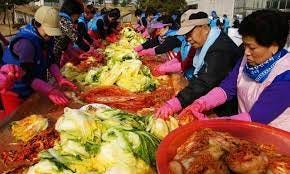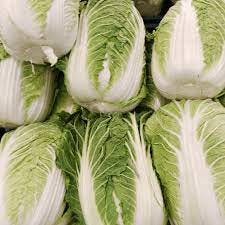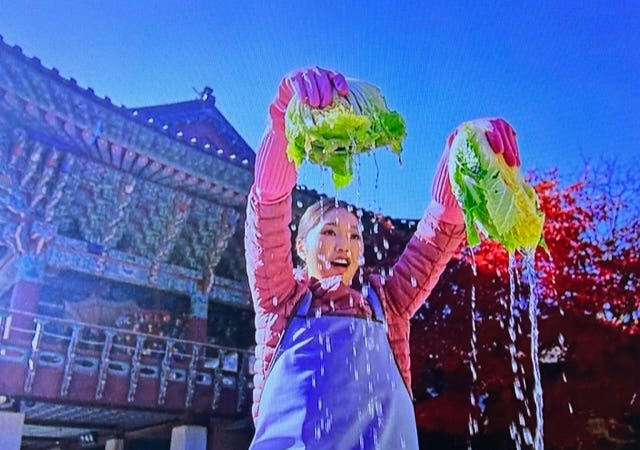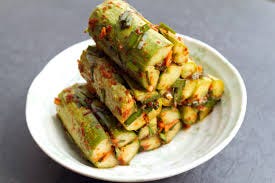Kimchi!
Part 1: How the national dish of South Korea found its way into our hearts minds and guts.
As National Kimchi Day (22nd November) approaches, my thoughts have turned to kimchi. In this week’s survey, I asked Instagram the following question:
Hot, spicy, fermented, with an unmistakeable odour that’s more pungent than delicious, I thought the national dish of Korea would surely have a “marmite” quality.
However, as you can see, the results were an almost unanimous YES, love it from almost 90% of respondents - and one who replied that they would love it if only it wasn’t so darned hot! Now, people that follow my instagram account are not exactly representative of the population at large, but still, an impressive statistic. When I first started doing fermentation workshops eight years ago, hardly anyone had tasted it, many had never heard of it and it was rare to find someone that had made it.
While vegetable fermentation feels new to us in the UK, Koreans have been preserving food this way since at least the time of the Three Kingdoms ( around 2.5 thousand years ago), having learned that it was an excellent path to both preservation and nourishment during harsh winters. Having developed over millennia, in connection with the Korea’s long agricultural history, it’s existence is firmly embedded within the nation’s psyche. There is even a World institute of kimchi (WIKIM) in Gwangju, whose mission is to…
“Perform overall R&D related to kimchi to enhance the reputation of Korea as the country of origin of kimchi and establish a global kimchi culture in order to contribute to the development and advancement of the kimchi industry”
The importance of kimchi in South Korea can’t be underestimated. A population of 50 million consumes about 2 million tonnes of it annually, about 60% of which is still made either in the home or the local community.
Kimjang
This is a cultural event where every autumn, huge quantities of Baechu (cabbage) kimchi are made by communities and families throughout the country – in quantities enough to last for months in a process which can take several days. November is the perfect time of year, as all the ingredients required are at their best then.
So significant is Kimjang that it was added to the Unesco intangible cultural heritage list in 2013, with the description “Kimchi forms an essential part of Korean meals, transcending class and regional differences. The collective practice of kimjang reaffirms Korean identity and is an excellent opportunity for strengthening family cooperation”.
The awakening
Gradually, kimchi has made its way from the confines of the” Land of the Morning Calm” to the menu of every self-respecting hipster café, but how did this happen?
One of the first mentions from the west was over 100 years ago, when the American Missionary, Horace Grant, (The Call of Korea”, 1908) wrote:
“Koreans use all kinds of vegetables, even rough and untasted ones, to make various kinds of kimchi. The most common type is the salted pickles served in every meal. They never get enough of it. Cabbage is the main ingredient for this cuisine but turnips, cucumbers and giant radishes are also essential minor ingredients. Most foreigners consider kimchi excellent, a masterpiece rich in spices, nuts, fish etc.. However, it is surely an acquired taste”.
It wasn’t until the Seoul Olympics in 1988 that kimchi and “everyone” were formally introduced; officials of the games were in conflict about just how much to spotlight their national dish - would it be alienating to foreigners with its pungent smell and spiciness? In the event, it was made an official food of the games, and there had been no need to worry - visitors embraced it willingly.
Thereafter, kimchi began gradually popping up all over Europe and America, but in recent years, its impact has been quite staggering - and there could be a reason in addition to deliciousness. South Korea has, it seems, realised the power of its national dish as a form of “soft capital” which can be used to expand its influence globally, in conjunction with the export of K-pop and Korean film;
a good strategy as economically they’re going from strength to strength. It’s also keen to ensure that the world knows that Korea, as opposed to Japan or China, where pickled vegetables are also culturally important, is kimchi’s one and only home.
Kimchi – a definition
While there are hundreds of different varieties of kimchi, in 2001, Korea lobbied for an international standard to help protect it from imitations – as per Codex Alimentarius ( a commission affiliated with the WHO and UN), it’s recorded as
“ fermented food that uses salted napa cabbages as its main ingredient mixed with seasonings, and goes through a lactic acid production process at a low temperature”.
This became necessary because over the years there have been various kimchi “scuffles” over definitions and trade - first with Japan in 1996, where Korea argued that Japanese commercial kimchi wasn’t true kimchi because it wasn’t fermented. More recently in 2020 with China, when the Chinese brined vegetable dish Pao Cai was awarded ISO status ( by the International Organisation for Standardisation). A Chinese news agency mistakenly reported that the award was recognition of “an international standard for the kimchi industry led by China”. This made South Koreans very cross indeed - it seems that in fact it was more an issue of semantics than actual recipe stealing as Pao Cai and Kimchi are its true both pickles, but not that closely related in either preparation, flavour, method of fermentation or nutritional benefit. The relationship between these nations and Kimchi is complex though, as much of the red pepper powder used and ready-made kimchi consumed in South Korea, does, in fact, come from China.
Spreading the word
A recent WIKIM publication “Hello Kimchi” directly encourages other nations to create fusion dishes. This magnanimous approach suggests that Korea feels secure in in its “ownership” of kimchi and quite in contrast to the furore that arose when Jamie Oliver attempted to use Jamaican jerk seasoning for rice and was accused of cultural appropriation. So let your imagination run wild; kimcheese toasties, kimchi ketchup, kimchi bolognese, kimchi baked beans, kimchi quiche, it seems that anything and everything is on the menu!
South Korea is so determined that everyone should sit up and take notice that they sponsored an enormous ad at Piccadilly Circus…
and have even been using streaming platforms ensure that kimchi becomes embedded into all our lives – for the youngsters in South Korea as much as anything – they’re no different to the rest of the world as globalisation of convenience and ultra processed foods threatens local food culture.
A nation of kimchi aired recently on Netflix. Have you seen it yet?
It’s definitely worth a watch; a two parter all about the different types of kimchi made in the various regions of Korea. Three Korean celebrities take us on a tour, and a large part of each programme comprises them cramming enormous mouthfuls of kimchi into their mouths, including live baby octopus kimchi, proclaiming “it’s so refreshing!”. This is an interesting description for me, as it’s the last word I’d use personally, but it features so regularly it must mean something that doesn’t quite translate!
In any case, it shows that you can make kimchi from literally anything – all kinds of vegetables can be salted and wrapped in the spicy paste – usually containing gochugaru chilli powder, pear or apple, onion or leek, garlic and often ginger, rice porridge and stock for additional flavour. Some kimchis are fermented for 3 days, then fridge-aged (like mine); others are fermented for months. Seafood is a common feature – saujeuot or small shrimps, and/or octopus are commonly added, or fish sauce. It clearly shows kimchi’s cultural significance and the importance of kimjang. One might go as far as saying that there’s a slightly aggressive propagandist edge to it all, but I’ll let you make your own decision there!
So are we any good at making kimchi?
I was curious to know what Koreans living here in the UK feel about our new-found enthusiasm for kimchi and our attempts to make it. Rebecca Ghim, a Korean London based kimchi maker and member of the Fermenters’ Guild kindly helped me out by answering these questions…..
It’s commonly believed that everyone in South Korea eats kimchi every day for every meal - is this true?
Yes, we eat kimchi every meal but as westernisation have changed our diet, some families (usually a posh one) will prefer sandwich or smoothie for breakfast.
Do you make kimchi at home? Once a year at kimjang?
Kimjang is once a year around end of Nov or early Dec. But other kinds of kimchi we make yearly. Cucumber kimchi for summer, spring onion kimchi for spring, mustard green kimchi is also during spring, mooli kimchi during autumn, etc.
What do you think about non native Koreans’ attempts to make kimchi?
It’s usually easy to tell if someone puts a lot of effort to make the quality nice and learn about the stories behind the recipes versus when someone is cutting corners and mimicking only certain aspects for profit. I think food moves with people and as I’m doing my business for survival, I know most people do the best they can so I try not to look at it with harsh criticism. But most of all, I think smart customers know when the product is good or not so I tend to trust that. I think Eaten Alive and Kim Kong Kimchi is pretty good, of course not as good as back home. But some of the others are quite poor in flavour!
What’s your favourite type of kimchi?
My personal favorite is perilla leaves and mustard green :)
Rebecca’s company “The Ferm” makes authentic and completely delicious kimchi that you can buy online by following this link….
In Conclusion
It seems that kimchi’s arrival on our shores has been met, deservingly in my opinion, with open arms. One could even say it’s a privilege to have easy access to something that has such a complex history and deep cultural significance. Have you made your own? If not, now is the time:
Just two spots remaining for January’s “from miso to kimchi and beyond” workshop, or my recipe and method can be found in the book wot i wrote Fermented Foods: a practical approach, available here (signed 😉)…… or on the Amazon.
Coming Soon
Catch up with me next edition for part 2 – issues with making authentic kimchi here in the UK and the principle of Son Mat (hand taste), which will be followed by part 3 which talks about “Yaksikdongwon“, the Korean philosophy linking nutrition and diet, and why kimchi really is good for you!
REFERENCES:










What a fascinating read, Caroline!
Thank you for that - I look forward to the parts 2 & 3 and to watching A Nation of Kimchi on Netflix.
Only a little decanted jar of mine left from your fab workshop “From Miso to Kimchi and Beyond” so will be making more before too long.
I feel rather envious of those attending in January, who still have it to enjoy - they will love it!